Grand Trunk Pacific Railway
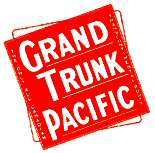 | |
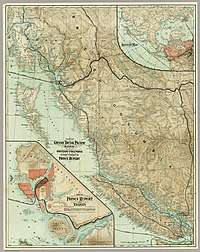 | |
| Reporting mark | GTP |
|---|---|
| Locale | Ontario, Manitoba, Saskatchewan, Alberta, British Columbia |
| Dates of operation | 1914–1919 |
| Successor | Canadian National Railway |
| Track gauge | 4 ft 8 1⁄2 in (1,435 mm) standard gauge |
The Grand Trunk Pacific Railway (reporting mark GTP) was a historical Canadian transcontinental railway running from Winnipeg to the Pacific coast at Prince Rupert, British Columbia. East of Winnipeg the line continued as the National Transcontinental Railway (NTR), running across northern Ontario and Quebec, crossing the St. Lawrence River at Quebec City and ending at Moncton, New Brunswick. The Grand Trunk Railway (GTR) managed and operated the entire line.
Largely constructed 1907-14, the GTPR operated 1914-19, prior to nationalization as the Canadian National Railway (CNR). Despite poor decision-making by the various levels of government and the railway management, the GTPR facilitated huge social benefits in the form of local employment opportunities, a telegraph service, and freight, passenger and mail transportation.[1]
History
Proposal
The Canadian Pacific Railway (CPR) transcontinental and its feeder routes operated closer to the Canada–US border. Seeking a transcontinental to open up the central latitudes, the Government of Canada made overtures to the GTR and Canadian Northern Railway (CNoR). Both these regional operators in eastern[2] and central Canada initially declined, because projected traffic volumes suggested unlikely profitability.[3] Realizing expansion was essential, a GTR attempt to amalgamate with the CNoR proved unsuccessful. The GTR finally negotiated to construct only the western section, financed entirely by government loans, while the federal government would build the eastern sections as the NTR. The respective legislation passed in 1903.
Nearer to Asia than Vancouver, Port Simpson[4] was located about 20 km southeast of the southern entrance to the Portland Canal (which forms part of the boundary between British Columbia and Alaska). In 1903, when friction arose in Canada over the Alaska boundary decision favouring US interests, US President Theodore Roosevelt threatened to send an occupation force to nearby territory. In response, Prime Minister Wilfrid Laurier changed the terminal location to the more easily defendable Kaien Island (Prince Rupert).[5]
Construction
Overview
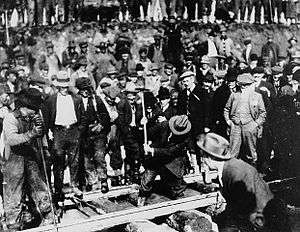
During the official ceremony on September 11, 1905 at Fort William, Ontario, Prime Minister Laurier turned the first sod for the construction of the GTPR. From there, the Grand Trunk Pacific Construction Company built a 190-mile section of track, connecting with the NTR near Sioux Lookout. For contractual purposes, Winnipeg to Wolf Creek (Edson, Alberta) was the Prairie Section, and Wolf Creek to the Pacific was the Mountain Section.[6] Foley, Welch and Stewart (FW&S) was selected as the prime contractor for the latter.[7]
Construction began on the Canadian Prairies in 1905, the year that the provinces of Alberta and Saskatchewan were established, proceeding west to Saskatoon, Saskatchewan in 1907, and Edmonton, Alberta in 1909. The GTPR followed the original Sandford Fleming "Canadian Pacific Survey" route from Jasper, Alberta through the Yellowhead Pass,[7] and the track-laying machine crossed the BC/Alberta border in November 2011.[8] The more northerly Pine Pass option, as specified in its charter, may have been a better choice in terms of developing traffic, and in improving the current CNR network (especially if the later Pacific Great Eastern Railway route had opted for the Monkman Pass crossing).
To secure concessions from the BC provincial government, eastward construction from the Pacific Coast began in 1907.[9] The last spike ceremony, heralding completion of the rail line across the prairies, through the Canadian Rockies, and to the newly constructed seaport at Prince Rupert, was held one mile east of Fort Fraser, British Columbia on April 7, 1914.[10]
Construction Crews
Claiming labour shortages, the GTP was unsuccessful in obtaining government approval to bring in unskilled immigrants from Asia.[11] By late 1912, 6,000 men were employed east of Edmonton.[12] Although contractors prohibited liquor in camps, bootlegging was rampant.[13] FW&S provided hospitals and medical services, charging employees one dollar per month.[14] The articles for the Grand Canyon of the Fraser, Dome Creek, McGregor, Upper Fraser, and the BC communities within the Category:Grand Trunk Pacific Railway stations, outline construction through specific localities.
Flat-bottomed Sternwheelers
FW&S operated five steamboats to supply their camps advancing east from Prince Rupert on the Skeena River. Launched in 1908, the Distributor and Skeena remained until 1914, as did the Omineca, purchased in 1908. Launched in 1909, the Operator and Conveyor were disassembled in 1911, transported to Tête Jaune and relaunched in 1912 on the Fraser River.[15][16][17] Detailed articles cover the sternwheelers Skeena, Operator, and Conveyor and their roles on the Skeena River, and on the Fraser River.
Fraser River Scows
During the construction phase from Tête Jaune to Fort George thousands of tons of freight, both for railway construction and merchants, travelled downstream from the railhead by scow.[18][19] In 1913, when scowing on this part of the river peaked, about 1,500 men were employed as scowmen, or "River Hogs" as they were generally called. In high water, the trip from Tête Jaune took five days and in low water up to 12 days, because of the shallow bars. Each vessel measured about 40 feet long and 12–16 feet wide and carried 20-30 tons. Two men crewed each end. The Goat River Rapids, Grand Canyon, and Giscome Rapids, were extremely dangerous, with wrecks and drownings common. Dismantlers purchased the scows that survived the journey, selling the used lumber primarily for house building.[20]
Real Estate Development
The funding for railway expansion depended upon returns from the sale of land acquired by the railway. The Grand Trunk Pacific Town & Development Co. was responsible for locating and promoting strategic town sites.[21] However, the priority of maximising profit undermined the economic prosperity of communities and other businesses, hampering the increase in traffic volumes essential for the GTP’s own survival.[22] In what would become Prince George, the company purchased the First Nations reserve for a railway yard and a new town site.[23] The GTPR also caused the displacement and socio-economic destruction of native communities along the route, many of whom had social and economic values in conflict with those of the railway.[24]
Initial Train Timetable
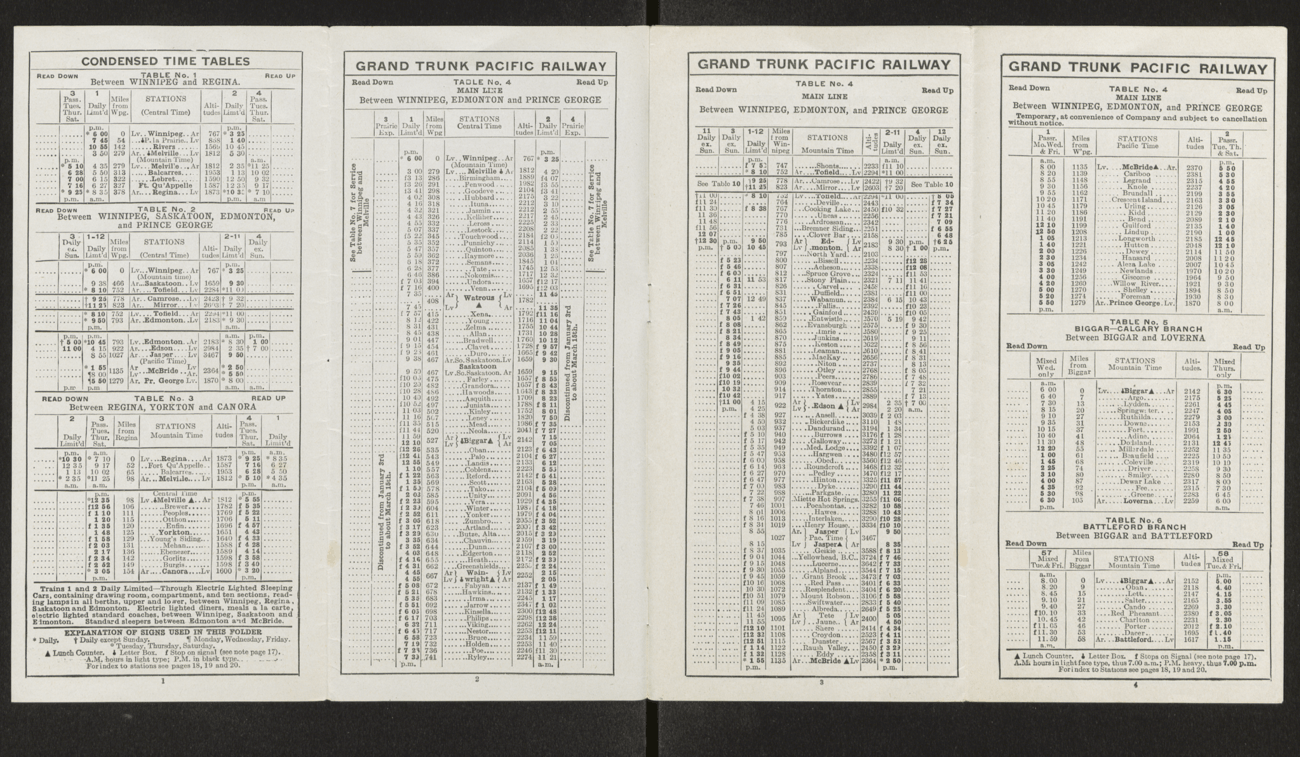
.
GTPR Steamships
Beginning in 1910, a GTPR steamship service operated from Prince Rupert. The first ship, the SS Prince Albert (formerly the Bruno built in 1892 at Hull, England), was an 84-ton, steel-hulled vessel and travelled as far as Vancouver and Victoria. Next, the SS Prince John (formerly the Amethyst built in England in 1910), travelled to the Queen Charlotte Islands. Built in 1910, the much larger SS Prince George and SS Prince Rupert, both 3,380-ton, 18-knot vessels, could carry 1,500 passengers with staterooms for 220. These ships operated a weekly service from Seattle to Victoria, Vancouver, Prince Rupert and Anyox.[25]
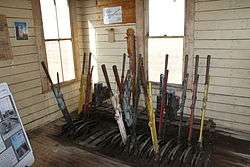
Ancillary Facilities
The GTPR built the Fort Garry Hotel in Winnipeg, and the Hotel Macdonald in Edmonton. Construction of the Chateau Prince Rupert did not proceed beyond the foundations laid in 1910. Its forerunner, the temporary GTP Inn, was demolished in 1962.[26]
When built in 1910, the Grand Trunk Pacific dock in Seattle was the largest on the west coast. On July 30, 1914, fire destroyed the facility. The company’s Prince Rupert dry-dock, completed in 1915, was dismantled during 1954/55.[27][28]
Operations
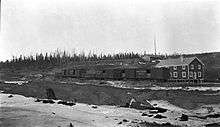
The CNoR tracklaying through the Canadian Rockies in 1913 roughly paralleled the GTPR line of 1911, creating about 100 miles of duplication. In 1917, a contingent from the Corps of Canadian Railway Troops added several crossovers to amalgamate the tracks into a single line along the preferred grade as far west as Red Pass Junction (misidentifed as 36 miles west of Red Pass on Google Maps). The surplus rails were lifted and the heavier grade GTPR ones shipped to France for use during World War I. By this time, both railway companies were in dire financial straits.[29][30]
In March 1919, after the GTPR defaulted on construction loans to the federal government, the federal Department of Railways and Canals took over all GTR operations until July 1920, when the CNR assumed control.
Current status
Today, the majority of the GTPR is still in use as CN's (name change to Canadian National or acronym "CN" in 1960) main line from Winnipeg to Jasper. The former CNoR line, and a later connection to Tête Jaune Cache, merge north of Valemount, before continuing south to Vancouver. The former GTPR line through Tête Jaune Cache to Prince Rupert forms an important CN secondary main line. The GTPR's high construction standards,[31] and the fact Yellowhead Pass has the best gradients of any railway crossing of the Continental Divide in North America gives the CN a competitive advantage in terms of fuel efficiency and the ability to haul tonnage.
After a century languishing far behind Vancouver, the Port of Prince Rupert has grown in importance since the early 2000s. Redeveloped terminal infracture, less municipal congestion than other West Coast ports, proximity to the great circle route from East Asia to North America, and a fast connection to the Midwestern United States along the former GTPR route, have reduced transportation times.
Footnotes
- ↑ The Grand Trunk..., pp. 107-108
- ↑ The Grand Trunk..., p. 13
- ↑ The Grand Trunk..., p. 9
- ↑ The Grand Trunk..., pp. 13-15
- ↑ Hayes, Derek (1999), Historical Atlas of British Columbia and the Pacific Northwest, Vancouver: Cavendish Books, p. 190, ISBN 1-55289-900-4
- ↑ The Grand Trunk..., p. 23
- 1 2 The Grand Trunk..., p. 14
- ↑ Fort George Herald, 23 Dec 1911
- ↑ The Grand Trunk..., pp. 16 & 23
- ↑ The Grand Trunk..., p. 24
- ↑ Fort George Tribune, 25 Dec 1909
- ↑ Fort George Tribune, 16 Nov 1912
- ↑ The Robson Valley..., p. 121
- ↑ The Grand Trunk..., p. 45
- ↑ Fort George Herald, 6 Jan 1912
- ↑ The Robson Valley..., p. 107
- ↑ The Grand Trunk..., p. 37
- ↑ http://fhnas.ca/scow-boats-heavy-haulers-athabasca-river-alberta-canada/
- ↑ The Grand Trunk..., p. 40
- ↑ Prince George Citizen, 26 May 1938
- ↑ The Grand Trunk..., pp. 26-28
- ↑ Leonard, Frank. (1996). A Thousand Blunders: The Grand Trunk Pacific Railway and Northern British Columbia. UBC Press, pp. 274-277
- ↑ The Grand Trunk..., p. 26
- ↑ MCDONALD, JAMES A (1990). "BLEEDING DAY AND NIGHT: THE CONSTRUCTION OF THE GRAND TRUNK PACIFIC RAILWAY ACROSS TSIMSHIAN RESERVE LANDS" (PDF). Canadian Journal of Native Studies.
- ↑ http://www.trainweb.org/oldtimetrains/CNR/gtp/steamships.html
- ↑ https://books.google.ca/books?id=L7VZVMIu7u0C&pg=PA125&lpg=PA125&dq=chateau+prince+rupert,+history&source=bl&ots=kokOgHhh-J&sig=e5bVc60xO6-9qns85tFLRHOWZro&hl=en&sa=X&ved=2ahUKEwi8rbPWlOvcAhVEx1QKHXiNBzYQ6AEwDXoECAAQAQ#v=onepage&q=chateau%20prince%20rupert%2C%20history&f=false
- ↑ http://shipbuildinghistory.com/canadayards/princerupert.htm
- ↑ https://royalbcmuseum.bc.ca/exhibits/living-landscapes/northwest/boatbuilding/drydock.html
- ↑ The Grand Trunk..., pp. 98-101
- ↑ Prince George Citizen, 20 Sep 2001
- ↑ The Grand Trunk..., pp. 98, & 102-103
References
- http://pgnewspapers.pgpl.ca/fedora/repository
- Morrow, Trelle A. (2010). The Grand Trunk Pacific and other Fort George stuff. CNC Press.
- Wheeler, Marilyn. (1979). The Robson Valley Story. McBride Robson Valley Story Group